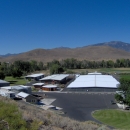About Us
Marble Bluff Fish Passage and Research Facility is located in Nixon, Nevada and is one of three facilities within the Lahontan National Fish Hatchery Complex. Constructed in 1975, the fish passage fish passage
Fish passage is the ability of fish or other aquatic species to move freely throughout their life to find food, reproduce, and complete their natural migration cycles. Millions of barriers to fish passage across the country are fragmenting habitat and leading to species declines. The U.S. Fish and Wildlife Service's National Fish Passage Program is working to reconnect watersheds to benefit both wildlife and people.
Learn more about fish passage facility includes Marble Bluff Dam, fishway, and fish lock. The fish lock can move up to 3,000 fish every 15 min during the spawning season. In some years over 750,000 endangered Cui-ui may pass through the fish lock and since 2011, when Pilot Peak Lahontan cutthroat trout started migrating back up the Truckee River, we have continued to see increasing numbers every year, the highest being 1,545 during the 2021 spawning season.
The facility is operated by the Lahontan Fish and Wildlife Conservation Office and maintained in partnership with the U.S. Bureau of Reclamation. The facility is located within the boundaries of the Pyramid Lake Paiute Tribe reservation and all activities are conducted in partnership with the Pyramid Lake Paiute Tribe.
Our Mission
The mission of the Marble Bluff Fish Passage and Research Facility is to assist and monitor fish spawning migrations from Pyramid Lake into the Truckee River in support of endangered Cui-ui and threatened Lahontan cutthroat trout recovery, tribal trust and recreational fishing.
Our History
Marble Bluff Fish Passage and Research Facility is located on the Truckee River approximately 50 miles downstream of Reno, Nevada and approximately three miles upstream of Pyramid Lake. The dam and fishway were constructed between 1973 and 1975 by the Bureau of Reclamation under the Washoe Project Act for the restoration of the Pyramid Lake Fishery. The dam was constructed to prevent an erosive head-cut from progressing upriver and destroying habitat upstream and the fish passage fish passage
Fish passage is the ability of fish or other aquatic species to move freely throughout their life to find food, reproduce, and complete their natural migration cycles. Millions of barriers to fish passage across the country are fragmenting habitat and leading to species declines. The U.S. Fish and Wildlife Service's National Fish Passage Program is working to reconnect watersheds to benefit both wildlife and people.
Learn more about fish passage facility was built to provide passage either 1) over the dam through mechanized passage or 2) around the dam through a three mile long earthen fishway. Early designs for both methods have been extensively modified over the years to improve the ability to pass large numbers of Cui-ui.
Some of the early designs included
- Mechanized passage
- The original design utilized a river trap located at the base of the dam that conveyed Cui-ui out of the water to a fish building 40 foot above. In the fish building biological data and gametes were collected before they were released upstream.
- In 1987, the river trap was modified to hold Cui-ui in 18 inches of water and while better for the fish, limited the number of fish that could be passed at a time.
- The river trap was replaced with a fish lock in 1996 to keep fish in the water during the entire process. A sub-sample station was also added to the exit channel to allow for continued collection of biological data and gametes.
- Fishway
- Initially consisted of a terminal ladder at the mouth and three intermediate ladders evenly spaced up the channel. At the top of the channel fish would enter the fish building to have biological data and gametes collected before being passed upstream.
- Wooden baffles were installed between 1973 and 1983 to the three intermediate ladders to slow water velocities through the ladders.
- A tilting weir was added to the terminal ladder in 1995 to help regulate the number of fish entering the fishway.
- An experiment meander channel was built in 1996 to replace the terminal ladder and improve the entrance to the fishway. The tilting weir was relocated to the new entrance.
- Overall the design of the fishway does not support Cui-ui migration behavior adequately and a new design is underway.
Currently the fish lock is the main method of fish passage at the facility. Over the years improvements have continued to be made to the fish lock to better facilitate passage of the spawning runs of both Cui-ui and Lahontan cutthroat trout. Use of the fishway is limited to only those years when the river is inaccessible due to poor fish passage conditions at the mouth of the river.


